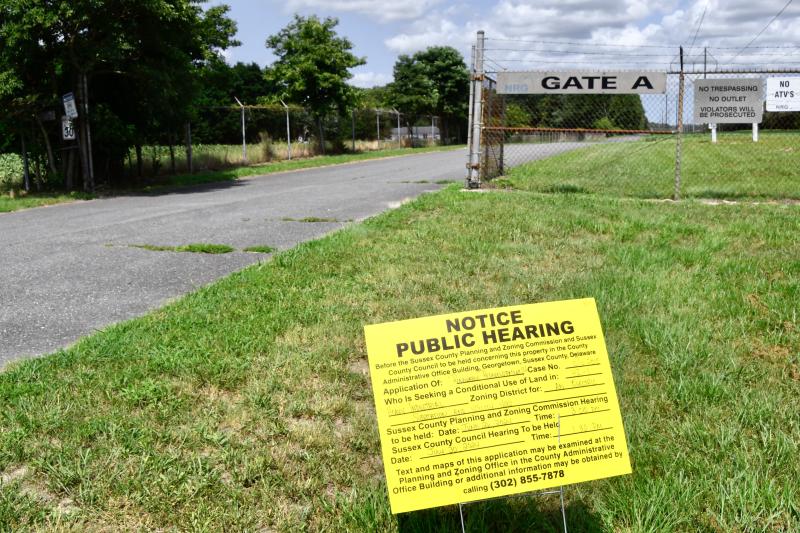Substation hearing morphs into US Wind debate
A proposed conditional use filed by Renewable Redevelopment LLC for a substation near the Indian River power plant sailed through the July 10 Sussex County Planning & Zoning Commission process with no opposition testimony. That was not the case during Sussex County Council’s July 30 hearing.
The fact that the applicant is a subsidiary of US Wind Inc. is what attracted the attention of the public. The substation would be a crucial part of the company’s offshore wind project. Four cables from the offshore turbines would pass 60 feet under the Atlantic Ocean, come ashore 9 feet deep at 3R’s Beach and Route 1 near Bethany Beach and be buried 6 feet under Indian River Bay to the substation site near the Indian River power plant.
US Wind has plans to place up to 121 wind turbines 10 to 12 miles off the Ocean City, Md. coast.
Attorney: Land-use question
Although Jim Fuqua, the applicant’s attorney, said the conditional-use application had nothing to do with the merits of offshore wind, the hearing quickly developed into people testifying against the US Wind project. Fuqua said the application was a land-use decision.
“This is not about the federal or state permitting process with development of offshore wind. It’s not about the benefits of offshore wind or its impacts. It’s a question of land use. Is this site appropriate for an electric substation?” Fuqua asked.
However, public testimony focused on opposition to the wind turbine project, questioning nearly aspect of the plan. Many said it was a Maryland project and doesn’t belong in Delaware.
At the end of the hearing, council members deferred a vote to a future meeting.
About the substation
Fuqua said the 140-acre parcel northwest of Gate A Road and one mile northeast of Iron Branch Road near Millsboro is zoned HI-1, heavy industrial district, where uses such as a substation are permitted with a conditional use. He said that 23.5 acres of the parcel would be used for the substation.
The attorney said Renewable Redevelopment LLC is a subsidiary of US Wind based in Baltimore, Md.
The company purchased the parcel in December 2023 from Indian River Power LLC. He said the parcel has 71 acres of woodland wetlands and 68 acres of wooded uplands. Nearly 22 acres of trees would be removed during construction.
The parcel is located west of the Indian River power plant, which began operation in 1957. Fuqua said the coal-powered plant is in the process of being dismantled with one unit still in operation.
The substation would be connected to the electric grid.
He said the project includes transformers and other equipment, and unmanned control buildings. The substation would have no employees and be operated remotely.
Fuqua said the closest residence is 1,700 feet away. The substation would be buffered with existing trees. The plan includes a 50-foot buffer from wetlands, a 7-foot security fence with barbed wire, a locked gate with emergency vehicle access and signs with emergency contact information.
“It’s the same as other substations throughout Sussex County,” Fuqua said.
He said the site was chosen because it is zoned HI-1. Fuqua said the project complies with the county’s land-use plan, which encourages alternative sources of energy and the reuse of industrial sites. “It’s in full compliance with land-use regulations and the goals of the Sussex County comprehensive plan,” he added.
Benefits questioned
Fuqua said the benefits to Sussex County include $250 million in upgrades to the electric grid, jobs for construction and operation, funding for dredging and $40 million to beach towns paid out $100,000 per year for 20 years.
“We will benefit because this is the future of what renewable energy is going to be,” Fuqua said.
“This is speculation. It’s unproven. You have no basis to say this is the future, although some want it to be,” said Councilman John Rieley.
Rieley took US Wind’s Gener Gotiangco to task on the potential benefits of the substation and offshore wind project to Sussex County. Gotiangco is US Wind’s senior director of energy and development.
Gotiangco said the US Wind contract is with the State of Maryland and they are obligated to receive the capacity from the substation. “We have to fulfill that obligation first, and then any excess capacity will be sold in the merchant stream in Delaware,” he said.
“So there’s no guarantee that Sussex County or Delaware will get any of this electricity?’ Rieley asked.
The engineer responded yes, but added there are other local benefits, including upgrades to the existing electrical system in Sussex County and the availability of renewable energy credits.
“We are not negotiating with Delaware to sell electricity, but we could negotiate in the future,” the engineer added.
Resident Stephanie Wager testified that Maryland rejected a proposal to bring the power into Maryland from the turbines. “It’s cheaper and easier for US Wind to bring it here to Sussex County,” she said.
She said the proposed site is in wetlands and is subject to regulations of the Coastal Zone Act.
“There is no benefit to Delaware that you can hang your hat on,” she said.
Stevenson: Protect the county
Dave Stevenson, director of the Center for Energy & Environmental Policy at the Caesar Rodney Institute, has been leading the charge against the project. He has an extensive background in environmental initiatives.
He offered a long list of reasons why the project is not good for Sussex County and Delaware. Foremost, he said, is potential loss of tourism dollars and decreased property values based on the visual impact of turbines 10 to 12 miles off the coast. He said research shows that more than one-third of vacationers in North Carolina would not return to beaches with turbines on the horizon.
Stevenson said a survey of 14,000 property owners within one mile of the Sussex County beaches shows that 86% are opposed to the project.
In other states, wind turbines are planned 25 miles (North Carolina) and 20 miles (New York) from the shore.
Commercial and recreational fishermen would also be impacted by the turbines, he said.
His research shows that electric rates savings may be 2.5% in the first year and 0.5% after that.
Stevenson said the Maryland legislature and Maryland Public Service Commission approved the project, and Maryland electric rate payers will pay for the upgrades.
“All credits and all capacity goes to Maryland. They will not have extra capacity, in my opinion,” he said.
He said even though New Jersey state officials and the federal government have approved offshore wind turbines in New Jersey, Cape May County is not allowing permits to be issued, and officials have sued the government.
“Delaware is on board and the federal government is on board. This is our only chance to weigh in and protest. You must protect the people you represent,” he said.
Mayor: Stop project
Fenwick Island Mayor Natalie Magdeburger had strong words in opposition to the application and the project. She said the town rejected the money offered by US Wind.
She said the council can stop the project and force US Wind to make changes. “You have a chance now to veto this pushing through. You will be able to protect the Sussex County residents from being burdened by the plan of Big Washington and Dover. At the end of the day, folks in Sussex County don’t want this,” she said. “It’s not what we want to see when we look out over the ocean. We need more science. This is a moment in time to exercise what is best for Sussex Countians.”























































